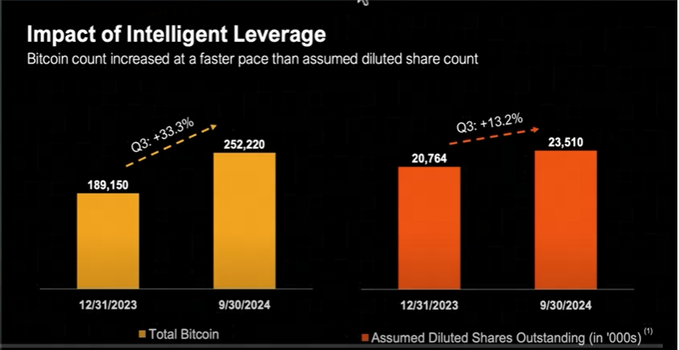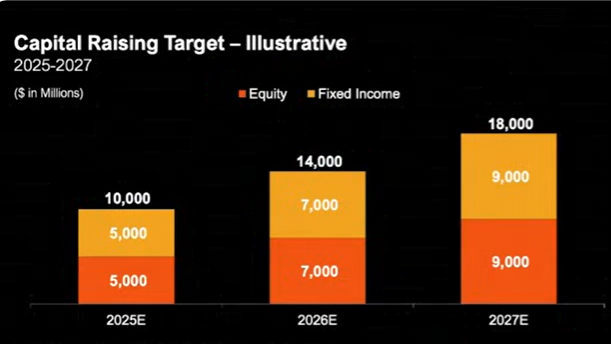MicroStrategy (MSTR) has become the focus of the market by issuing convertible bonds to massively purchase BTC. This article explores its investment logic and potential risks, and shares the author's reflections and cognitive upgrades. This article is from the article written by Jian Shu, organized and translated by PANews.
(Background: How long can the "BTC hoarding craze" following MicroStrategy's lead last in the US stock market?)
(Additional background: MicroStrategy added another $5.4 billion to buy 55,500 BTC: BTC at $97,000 is not expensive!)
MSTR (MicroStrategy), from the beginning of the year's $69 to last week's high of $543, has risen far more than BTC! What left a deep impression on me is that when BTC was suppressed due to the election, MSTR continued to sing high. This made me rethink its investment logic: it is not just riding the BTC concept, but has its own gameplay and logic.
MSTR's Core Gameplay: Issuing Convertible Bonds to Buy BTC
MSTR was originally doing BI (business intelligence reporting system), but this is already a sunset industry. Now its core gameplay is: through the issuance of convertible bonds to raise funds, massively buy BTC, and make it an important component of the company's assets.
1. What is a Convertible Bond?
Simply put, the company raises funds through the issuance of bonds, and investors can choose to take the principal and interest at maturity, or convert the bonds into the company's stocks at the agreed price.
- If the stock price rises sharply, investors will choose to convert, and the shares will be diluted accordingly.
- If the stock price does not rise, investors choose to take back the principal and interest, and the company needs to pay a certain amount of financial cost.
2. MSTR's Operating Logic:
- Use the money raised from the issuance of convertible bonds to buy BTC.
- In this way, MSTR's BTC holdings continue to increase, and the BTC value per share is also growing.
For example: based on the data at the beginning of 2024, the BTC corresponding to every 100 shares has grown from 0.091 to 0.107, and by November 16, it has risen to 0.12.
Understanding it in combination with the following figure will be clearer: The relationship between the BTC increased by MSTR through convertible bonds and the dilution of shares in the first 3 quarters of 2024

- In the first three quarters of 2024, MSTR increased its BTC holdings from 189,000 to 252,000 (an increase of 33.3%) through convertible bonds, while the total number of shares was only diluted by 13.2%.
- The BTC corresponding to every 100 shares has risen from 0.091 to 0.107, and the BTC equity is gradually increasing. We calculate at the beginning of the year: the price of 100 MSTR shares ($69) is $6,900, and the price of 0.091 BTC ($42,000) is $3,822, which seems very uneconomical compared to directly buying BTC (-45%). But based on this growth model, through continuous debt issuance, the BTC held per share will become more and more.
3. Latest Data:
On November 16, MSTR announced the acquisition of 51,780 BTC for $4.6 billion, bringing its total holdings to 331,200 BTC. Based on this trend, the BTC value corresponding to every 100 shares has already approached 0.12. From the perspective of BTC, the "equity" of MSTR shareholders is constantly increasing.

MSTR is the "gold shovel" of BTC
From the model, MSTR's gameplay is similar to using Wall Street leverage to mine BTC:
- Continuously issue bonds to buy BTC, and dilute shares to increase the BTC holdings per share
- For investors, buying MSTR shares is equivalent to indirectly holding BTC, and they can also enjoy the leveraged returns brought by the rise of BTC
By now, I believe readers can already see that this gameplay is more like a Ponzi scheme, using the newly raised funds to subsidize the equity of old shareholders, and continuing to raise funds round after round.
4. How long will this model continue to be unsustainable?
- Increased difficulty in fundraising: If the stock price does not rise, subsequent convertible bond issuance will become difficult, and the model will be difficult to sustain.
- Excessive dilution: If the speed of share issuance exceeds the speed of BTC accumulation, shareholders' equity may shrink.
- Model homogenization: More and more companies are starting to imitate MSTR's model, and after the competition intensifies, its uniqueness may be lost.
MSTR's logic and future risks
Although MSTR's logic is a bit like a Ponzi scheme, in the long run, the large US capital hoarding BTC has strategic significance. The total amount of Bitcoin is only 21 million, and the US national strategic reserve may occupy 3 million. For large capital, "hoarding coins" is not only an investment behavior, but also a long-term strategic choice.
But currently, the risk of MSTR's position is greater than the return, so everyone should be cautious in their operations!
- If the BTC price pulls back, MSTR's stock price may suffer a larger decline due to its leverage effect;
- Whether it can continue to maintain a high-growth model in the future depends on its fundraising ability and the competitive environment of the market.
Reflection and cognitive upgrade
In 2020, when MSTR first hoarded BTC, I remember that Bitcoin rebounded from $3,000 to $5,000 at the time. I thought it was too expensive and didn't buy it, while MSTR bought a large amount at $10,000. At that time, I still thought they were too stupid, but the result was that BTC rose all the way to $20,000, and I was the fool.
This time I missed MSTR, which made me realize that the operating logic and cognitive depth of the big capital bosses in the US are worth learning seriously. Although MSTR's model is simple, it represents a strong belief in the long-term value of BTC behind it. Missing out is not terrible, the important thing is to learn from it and upgrade your own cognition.






